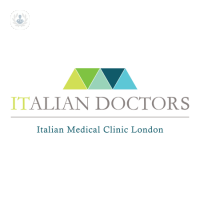What is periodontics?
Periodontics is the branch of dentistry that treats diseases of the gums and bones supporting the teeth.

What types of periodontal disease are there?
The most common periodontal diseases are gingivitis and periodontitis. Gingivitis affects the gums, the soft tissues that protect the teeth. Periodontitis is more complex and causes infections in the bone that holds the teeth in place and in other tissues, such as the periodontal ligament and the root.
What causes periodontal disease?
It is most commonly caused by the build-up of bacterial plaque on the teeth and gums, which eventually leads to tissue damage. These diseases cause redness and bleeding of the gums, either spontaneously or during brushing. Other causes include smoking, genetic inheritance, pregnancy and certain diseases, such as diabetes.
Factors that can cause gingivitis to progress to periodontitis include:
- Bacteria
- Genetic factors
- Stress
- Alcohol consumption
- Being overweight
- Smoking
- Systemic diseases (e.g. diabetes and osteoporosis)
- Drugs that cause gum overgrowth
- Poor oral hygiene habits
- Poorly positioned teeth
- Poorly fitted fillings
Tips for preventing periodontal disease
The best way to prevent periodontal disease is to maintain good oral hygiene, which controls the amount of plaque that builds up. Regular check-ups at the dentist are essential for an early diagnosis of the disease if it develops.
What does periodontal treatment involve?
Gingivitis is treated by professional prophylaxis (teeth cleaning), and root scaling and polishing in the case of periodontitis. Periodontal surgery may sometimes be necessary to remove bacteria, plaque, and tartar from the roots of the teeth.
11-13-2012 03-16-2023Periodontics
What is periodontics?
Periodontics is the branch of dentistry that treats diseases of the gums and bones supporting the teeth.

What types of periodontal disease are there?
The most common periodontal diseases are gingivitis and periodontitis. Gingivitis affects the gums, the soft tissues that protect the teeth. Periodontitis is more complex and causes infections in the bone that holds the teeth in place and in other tissues, such as the periodontal ligament and the root.
What causes periodontal disease?
It is most commonly caused by the build-up of bacterial plaque on the teeth and gums, which eventually leads to tissue damage. These diseases cause redness and bleeding of the gums, either spontaneously or during brushing. Other causes include smoking, genetic inheritance, pregnancy and certain diseases, such as diabetes.
Factors that can cause gingivitis to progress to periodontitis include:
- Bacteria
- Genetic factors
- Stress
- Alcohol consumption
- Being overweight
- Smoking
- Systemic diseases (e.g. diabetes and osteoporosis)
- Drugs that cause gum overgrowth
- Poor oral hygiene habits
- Poorly positioned teeth
- Poorly fitted fillings
Tips for preventing periodontal disease
The best way to prevent periodontal disease is to maintain good oral hygiene, which controls the amount of plaque that builds up. Regular check-ups at the dentist are essential for an early diagnosis of the disease if it develops.
What does periodontal treatment involve?
Gingivitis is treated by professional prophylaxis (teeth cleaning), and root scaling and polishing in the case of periodontitis. Periodontal surgery may sometimes be necessary to remove bacteria, plaque, and tartar from the roots of the teeth.


Periodontal plastic surgery for correction of gum recession
By Dr Nikos Mardas
2024-12-16
Gum recession is a common dental condition where the gum tissue surrounding the teeth begins to wear away or pull back, exposing more of the tooth or even its root. This can lead to increased sensitivity, aesthetic concerns, and a higher risk of decay or infection. Periodontal plastic surgery offers an effective solution to correct gum recession, protect the teeth and restore a natural gum line. See more
Experts in Periodontics
-
Dr Federico Tinti
DentistryExpert in:
- Periodontics
- Gingivitis
- Gingivitis and periodontitis
- Periodontal Surgery
-
-
Dr Kuljeet Mehta
DentistryExpert in:
- Periodontics
- Advanced implantology
- Gum graft
- Dental bone grafts
- Periodontal Surgery
- Bone and periodontal regeneration
-
Dr Sulaman Anwar
DentistryExpert in:
- Gingivitis and periodontitis
- Periodontal Surgery
- Dental implants
- Receding gums
- Periodontics
- Bruxism
-
Dr Tania Rafael Garcia
PeriodontologyExpert in:
- Periodontics
- Dental implants
- Tooth abscess
- Bone and periodontal regeneration
- Periodontitis
- Periodontal cleaning
- See all

Italian Doctors
Italian Doctors
24E Little Russell St, London, WC1A 2HS
No existe teléfono en el centro.
By using the telephone number provided by TOP DOCTORS, you automatically agree to let us use your phone number for statistical and commercial purposes. For further information, read our Privacy Policy
Top Doctors

Bespoke Dental Fulham
Bespoke Dental Fulham
Ground Floor, 275 New Kings Rd, London
No existe teléfono en el centro.
By using the telephone number provided by TOP DOCTORS, you automatically agree to let us use your phone number for statistical and commercial purposes. For further information, read our Privacy Policy
Top Doctors

TKC - The Kensington Clinic
TKC - The Kensington Clinic
6 Russell Gardens, Kensington
No existe teléfono en el centro.
By using the telephone number provided by TOP DOCTORS, you automatically agree to let us use your phone number for statistical and commercial purposes. For further information, read our Privacy Policy
Top Doctors
-
Italian Doctors
24E Little Russell St, London, WC1A 2HS, Central LondonExpert in:
- Cardiology
- Gastroenterology
- Obstetrics and Gynaecology
- Dentistry
- Paediatrics
- Psychiatry
-
Bespoke Dental Fulham
Ground Floor, 275 New Kings Rd, London, West LondonExpert in:
- Composite bonding
- Cosmetic dentistry
- Dental implants
- Complex restorative dentistry
- Invisible braces
- Periodontics (gum problems)
-
TKC - The Kensington Clinic
6 Russell Gardens, Kensington, Central LondonExpert in:
- Aesthetic Dentistry
- Dental Implants (replacing teeth)
- Dentistry
- Cosmetic dentistry
- Orthodontics
- Periodontics (gum problems)
- See all
- Most viewed diseases, medical tests, and treatments
- Chronic headache
- Botulinum toxin (Botox™)
- Platelet-rich plasma
- Cleft palate
- Tooth wear
- Tooth sensitivity
- Tooth abscess
- Facial pain
- Dental phobia
- Dental monitoring








